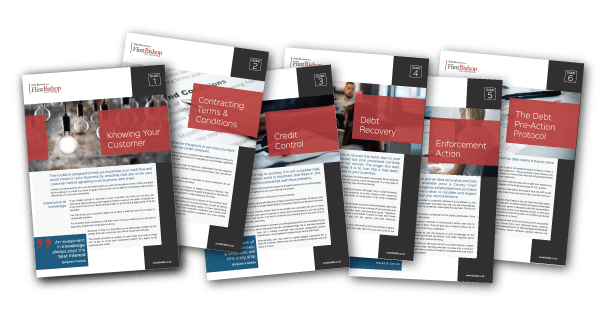A number of recent changes to the law have made life even more difficult for businesses owed money. Whether you are owed just a few thousand pounds or you carry the Greek national debt on your balance sheet, bad debts can be a serious problem. They can be the difference between profit and loss, employment and unemployment, solvency and insolvency. So, in a world where recent governments have made it easier to incur debts and harder to collect them, how can you best protect your business?
The history lesson
Before looking at recent trends, it is worth considering historic attitudes to money and debt. It is fair to say that society took a hard line!
Debtors and debt collection have their roots in ancient civilisations. In those times, if a debt could not be repaid, the debtor and his wife, children or servants were forced into what was called ‘debt slavery’, until the creditor had recouped his losses through their physical labour.
In England, the Statute of Bankrupts was introduced in 1542. The law regarded debtors as ‘crooks’ and ‘villains’. The Statute was designed to stop these ‘nefarious’ people from fleeing from the country. Even in 1705 when the slightly less severe Bankrupts Act was passed, attitudes towards debtors were unforgiving to say the least. In Fowler -v- Padget (1798), Lord Kenyon said “bankruptcy is considered a crime and a bankrupt in the old laws is called an offender”.
As an offence, debtors could be imprisoned. Under the 1813 Insolvent Debtors (England) Act, debtors could ask for freedom if they swore their assets did not exceed £20. However, their fate was in the hands of their creditors who could object and keep the debtor in jail. There were some infamous London debtors’ prisons including Fleet Prison, King’s Bench Prison and Marshalsea Prison.
Samuel Byrom, the son of the writer and poet John Byrom, was imprisoned for debt in 1725, as was literary genius Charles Dickens’ father, who was sent to the Marshalsea. In fact, Dickens is said to have been repeatedly embarrassed by his father’s financial misgivings and his somewhat imprudent character Micawber, from the novel David Copperfield, was apparently based on his father and the shame he brought on the family.
Incidentally, ‘Micawberish’ and ‘Micawberesque’ have become synonymous with a trait that you will no doubt have seen in some of your debtors: the optimistic expectation of better fortune, regardless of one’s current predicament. Perhaps Micawberism is the Dickensian example of the contemporary problem of ‘zombie companies‘ – those businesses that won’t quite die as they might just pull through, but until they do, put other healthier businesses at risk.
Regardless, the attitudes towards debtors up to this point were extremely negative, debtors often bringing shame upon their families and punished through forced labour, incarceration, etc. In Victorian England people began regarding debtors with a little more sympathy. The Bankrupts (England) Act 1825 allowed debtors to petition for their own bankruptcy – something which was only the right of a creditor before (though they did need the creditor’s agreement).
Then in 1869, the Debtors’ Act abolished imprisonment for debt. However, if debtors who had the means to pay their debt did not do so, they could still be sent to prison for up to six weeks – perhaps the first time recognising the distinction between the ‘can’t pay’ and the ‘won’t pay’ debtors.
This principle has underpinned much of the evolution of laws and practices relating to debtors over time. Forced slavery is long gone; even the harshest of credit managers will probably agree that this is inappropriate. Imprisonment likewise, although no doubt many of you will have encountered those ‘professional’ debtors that tread that thin blue line between legal and illegal. But has the stigma of debt also been largely eroded and has society become too tolerant of bad debt?
Recent years
It is no secret that for the past few years, we have all been bearing the financial scars of the frivolous years. Banks lent to anyone, governments encouraged enterprise, if you couldn’t afford something, someone else would foot the bill. There was a seemingly bottomless pit of credit available to anyone for anything. Micawber would have been redundant because everything was rosy.
The government encouraged entrepreneurism through the Enterprise Act in 2002, on the premise that people should be commended for taking risks. But in doing so, did they also chip away at the stigma of failure? In making it easier and more acceptable to fail at a time where incurring credit was fair game for all, did this change attitudes towards debtors?
Undoubtedly it must have done. When we discovered that the bottom had fallen out of the previously-presumed bottomless pit of credit, suddenly there were far more debtors. More people and businesses had borrowed beyond their means and with credit being so readily accepted as the norm during the good times, the dishonour of debt dissipated somewhat. People and businesses became victims of circumstances rather than incompetence; feelings of misfortune replaced embarrassment.
The rise of the zombie company was a sign of the times. Over-stretched businesses borrowing to pay off debts, incurring additional credit to discharge existing credit, just about surviving in the Micawberish hope that fortunes will change.
Fast forward to today
Nowadays, it could be argued that the law has gone full circle and is on the side of the debtor. The more normal it has become to have credit, the greater the number of debtors. And with greater numbers, the previously silent, shamed minority become increasingly noisy. Cue cringe-worthy TV ads offering help to write-off debts.
Additional laws get passed intending to protect those who can’t pay, the sound principle of which goes back to at least 1869. But these laws get used and abused by those who won’t pay. Take for example the rise of the phoenix company – a by-product of the Enterprise Act intended to encourage entrepreneurism, but which can often be misused so as to take full advantage of the concept of limited liability.
The new world has most-definitely become more pro-debtor than ever before, with a number of recent examples of changes to the law to make debt recovery harder than ever:
- Bailiffs can no longer force entry to property, meaning that their powers are often limited to asking nicely if a debtor wishes to let them in to seize goods. This inevitably weakens their effectiveness.
- Since last year, bailiffs have to now give at least one week’s notice to tenants before they attend rented premises to seize goods due to rent arrears, thereby giving unscrupulous debtors full opportunity to remove anything of value.
- Turnaround times within the court system can be incredibly slow, meaning that it can take weeks longer than it should to obtain CCJs against your debtors.
- As of last week, court fees increased for debts over £10,000 by up to 600%, which makes pursuing a CCJ prohibitively expensive for larger debts.
- It has been proposed that the minimum debt for making an individual bankrupt be increased from £750 to £5,000. A similar increase is also on the cards for winding up limited companies. This will remove a significant right of creditors to petition for bankruptcy in most routine cases and enable individual debtors to incur significant debts without the risk of bankruptcy for non-payment.
The current trends are great news for all the Micawbers out there; they allow plenty of scope for debtors to delay matters just a little longer in the hope or expectation of an upturn in fortunes. They are much bleaker reading for the businesses owed money by the Micawbers, or for those who still see a place for the Dickensian ideals of right and wrong.
The future
So where the odds are being increasingly stacked in favour of debtors, what can businesses do to limit their exposure and risk?
Firstly, remember that prevention is better than cure. Credit check your customers, set and monitor credit limits according to your customers’ risk profile. Ensure that your terms and conditions are valid, up-to-date and relevant to your internal procedures. We have created a series of free credit management and debt recovery toolkits containing numerous tips to minimise your bad debts, as well as a free 5 minute credit management audit – an interactive tool to identify those areas that you may be able to improve.
Secondly, if you do have an overdue account, act quickly. You will be far more successful chasing a recent debt than an older one; each day that goes by decreases your chances of recovery and increases the possibility of your overdue account becoming a bad debt. We can help you put in place the best and most effective strategy for dealing with overdue accounts bespoke to your business and your sector.
And remember that a return to the Dickensian view of debtors is very unlikely; don’t expect any favours from future governments and don’t expect any change in attitudes from debtors. You are in the best place to help yourself, so invest the time in getting your internal processes right and keep control of your own risk.
For more information, please contact us on 01332 226 474 or email: .
|
|


